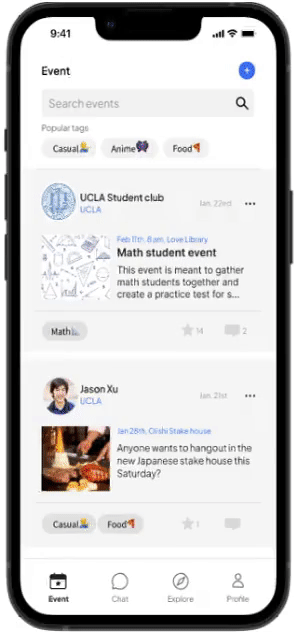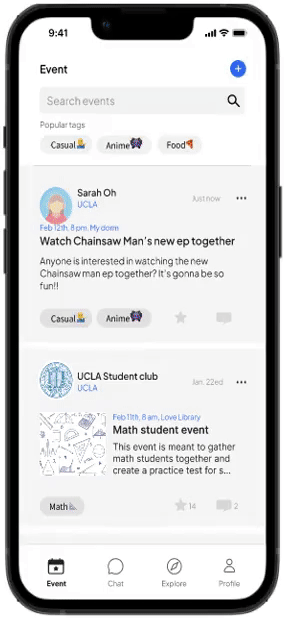Gather - a mobile application designed to help college students connect with like-minded individuals and explore new leisure activities together.
Role
UX designer
UX Researcher
UI designer
Illustrator
Tools
Figma
Adobe Illustrator
Project type
Solo project
Hypothetical project
Timeline
100 hours
Difficulty Making Friends Impacts College Students' Health
Many college students struggle with making friends, which can have a detrimental impact on their physical and mental health. As a former college student who experienced depression due to social isolation, I understand how challenging and lonely this can be. Unfortunately, the current market does not provide a solution for this issue.
No Perfect Solution Exists in the Market
To understand the market and identify existing or similar apps, I conducted a competitor analysis. My goal was to investigate what features are currently working or not working for competitors and to identify opportunities to differentiate my app. Through this analysis, I identified four apps that are either directly or indirectly related to my goal of helping college students establish friendships.
I found out that most of them are: 1. Focusing on dating, 2. Not secure & safe, 3. Not designed for college students, 4. Have unnecessary features
What are the thoughts of college students?
As a UX designer, I conducted five user interviews with current college students to better understand their perspectives and experiences in forming new friendships. My primary objectives were to gain empathy with my future users, identify pain points and motivations, and uncover opportunities to design a more effective app.
Here are some of the questions I asked during the interviews:
What situation will motivate you to make friends?
What social app do you use? Have you made friends on these apps?
Do you feel safe making friends online?
How do you make friends? Could you tell me the last time you made friends with someone?
Do college students want to have more friends? The answer is yes, I sent out surveys to college students and recent grads, and almost all of them (14 out of 15) wanted to make more friends and attend more events during college.
What I learned from these researches
Common Interests as a Key Facilitator of Friendship Formation
User interviews revealed that shared interests can be an important factor in fostering friendships, as they can create common ground and facilitate conversations.
Increase Social Opportunities Outside of Class
College students find it easier to make friends outside of class, as they are often looking for a change of pace and scenery.
Foster a diverse and inclusive community
Based on interviews, International students highlighted the value of connecting with others from their home countries, while the other interviewees expressed an interest in meeting people from diverse backgrounds and cultures.
Define the target users
Main target users:
International college students
Meet Aya, a vibrant college junior from Japan who's always excited to make new friends. As an exchange student, Aya is thrilled to immerse herself in the culture of the United States and explore new experiences. When she's not busy studying, Aya loves to dance and watch K-dramas. She's eager to discover new hobbies and make connections with people from all walks of life. However, being new to the United States, she currently has a limited social circle.
Secondary target users:
Domestic college students
Meet Jason, a passionate college senior who loves to explore the mysteries of ancient history, with a particular interest in ancient Chinese history. He is often found immersed in books at the library, and he is eager to connect with other students who share his fascination for history. Jason is planning to organize events to bring like-minded individuals together, but he is unsure of how to find these students and host successful events.
Designing for User Needs: Integrating Research Insights into the Design Process
I create the wireframes based on the research insights I got from the user interviews, competitor analysis, and secondary research.
Leveraging shared interests to connect users
For most of my interviewees, it’s easier to make friends when you have a comment interest. One of them made friends when playing video games, the other met her best friend during a music party. Some people have a hard time talking about themselves but a common interest brings people together and friendships are born.
User’s Profile
Other’s Profile
Enhancing social opportunities through event discovery
My interviewees mentioned that it’s easier to make friends outside of class in colleges because they already spend the majority of their time in universities and just want to leave after class. Having different kinds of activities to do outside of class not only is a relief from school work but also support social skill and promote both mental and physical health.
Events
Recommended Events
Enabling users to connect with others from diverse cultural backgrounds
Of the 5 interviewees I found, 2 of them were international students. They both have domestic friends but they also have groups of friends from their own countries because they feel more comfortable with people who understand their language, understand their culture, and share their values. It’s hard to study abroad and having a group like this can help them to adapt to a new environment faster and feel less lonely.
My other interviewees also expressed interest in meeting students from different backgrounds/cultures. One mentioned she was interested in Hong Kong and would love to make friends with students from Hong Kong.
Connection
Filter
Understand User Behavior through
Two Key Tasks
To gain a better understanding of my target users' needs and preferences, I developed two user flows focusing on two key tasks: finding a new student from one's country and posting an event. These flows will enable me to identify the steps users take to accomplish their goals, their pain points, and areas where my platform can improve user experience. By analyzing these flows, I can optimize the platform's design and features to better meet the needs of my target audience.
3 major improvements in my design based on users’ feedback
I developed basic interactive wireframes and conducted four user tests with a focus on three main flows: creating an account, creating an event, and finding a user from a specific country. Based on the feedback received from the users, I iterated on the design and made three significant improvements.
First Improvement
Streamlined Verification Process for Security and Efficiency
Originally, the verification process required users to scan both sides of their student ID to ensure a secure and reliable process. However, after receiving feedback from users that it was time-consuming and they were uncomfortable providing this information, I reevaluated the process.
As a result, I opted to use the student's email address and a verification code to ensure their identity, resulting in a faster and more straightforward process that doesn't require excessive personal information. This new process is also secure and reliable.
Second Improvement
Addition of the Activity section to user profiles
After conducting usability testing, I discovered that users expressed interest in being able to see what events and activities other users are attending or interested in.
To accommodate this, I added an Activity section to user profiles that display a user's recent activities, including comments, events they have shown interest in, past events attended, and more.
Third Improvement
Major Updates to the Explore Page
During user testing, it became clear that the filter function on the Explore page was not intuitive, causing confusion among users. To address this, I made significant updates to the page, including:
- Renaming the page from "Connection" to "Explore" to better reflect the page's purpose and make it more approachable.
- Replacing the search bar with a search button on the top right of the page, freeing up space and reducing clutter.
- Moving the filter button to a more prominent location, replacing the search bar with popular filter choices displayed underneath.
Adding some Excitement to my design
For the initial impression of Gather, I aimed to create a welcoming and engaging design. The primary typography that I chose was Plus Jakarta Sans, and the logo was designed using three distinct colors. The logo's three shapes represent the concept that although we are unique individuals, we can come together as a group.
What I learned from this project
After completing my first UX project, I learned some valuable lessons that will inform my approach in future projects.
Nothing is perfect, we need to create the “best” possible result under constraints
I realized that while I had high expectations for myself and the project, striving for perfection can be counterproductive. Instead, it's essential to recognize the constraints of the project and produce the best result possible within those limitations.
Validating the problem before proceeding
Another important lesson I learned was the importance of validating the problem before proceeding with the design process. By speaking with potential users and conducting market research, I was able to confirm that the problem I had identified was worth solving and would make a meaningful impact on college students' lives.
Conducting usability testing at an early stage
In my first version of Gather(I iterate Gather two times), I didn't test until the prototype stage, which resulted in significant changes and a lot of time and energy. However, when I conducted testing during the wireframe stage in my second version, I was able to make major updates quickly and efficiently.
Choosing the right methods and deliverables
This is crucial for a successful project. While I initially included many deliverables such as user stories and journey maps, I learned that they were not useful for solving the problem at hand. Moving forward, I will focus on using only the methods and deliverables that serve a clear purpose and help to solve the identified problem.
















